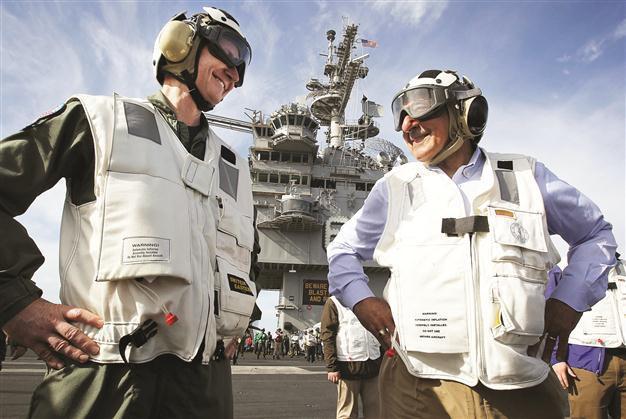US shows off naval muscles as Iran bids to decrease tensions
ABOARD THE USS ENTERPRISE / TEHRAN

US Defense Secretary Panetta (R), escorted by Admiral Walter E. Carter Jr. (L), watches day flight operations from the flight deck of the aircraft carrier USS Enterprise. REUTERS photo
The United States will not cut America’s fleet of 11 aircraft carriers to help trim the budget deficit, Defense Secretary Leon Panetta said Jan. 21, citing tensions with
Iran as an example of why the massive ships were so critical to national security.
Panetta was addressing about 1,700 sailors headed to the Gulf this spring aboard the
USS Enterprise, which after a half-century of service is about to embark on its final tour before being taken out of service in November. “The carriers play a major role in our force; not only today but they will play an important role in the future. You’re part of what keeps our force agile and flexible and quickly deployable and capable on taking on any enemy anywhere in the world,” Panetta said. “It’s for that reason the president of the U.S. and all of
us working at the Department of Defense have decided it is important to maintain our carrier force at full strength and means we’ll be keeping our 11 carriers in our force,” Panetta said to a swell of cheers in one of the ship’s hangars. The Pentagon has to find $487 billion in spending cuts in the next decade. He said maintaining the carriers, each of which carry nearly 80 aircraft and helicopters, was central to U.S. military projection in the Pacific and Middle East.
The USS Enterprise, cruising off Georgia, is supposed to be taken out of service at the year’s end after 51 years at sea. Panetta said the Enterprise, which is heading to the Middle East in March, would pass through the Strait of
Hormuz, the strategic shipping lane that Washington foe Iran is threatening to close. “It will be going through the Strait of Hormuz,” Panetta said, noting two US carriers – the USS Carl Vinson and the USS Abraham Lincoln – were already in the Gulf region. “Obviously we are fully prepared to deal with any contingency in that part of the world,” Panetta said. “We’ll continue to work with the international community, we’ll continue to put sanctions on them,” he said, referring to Iran. “We’ll continue to make those messages clear. The most important way to make those messages clear is to show we are prepared, we are strong, that we’ll have a presence in that part of the world,” Panetta added.
Tehran backs away
Meanwhile, apparently backing away from previous warnings to Washington not to enter the area, Iran’s Revolutionary Guard Corps (IRGC) said on the same day it considered the deployment of U.S. warships to the Gulf as part of routine activity, apparently backing away from previous warnings to Washington not to enter the area.
“U.S. warships and military forces have been in the Persian Gulf and the Middle East region for many years and their decision in relation to the dispatch of a new warship is not a new issue and it should be interpreted as part of their permanent presence,” IRGC Deputy Cmdr. Hossein Salami told the official IRNA news agency. There has been no U.S. aircraft carrier in the Gulf since the USS John C. Stennis left at the end of December last year. On Jan. 3, Iran told the Stennis not to return – an order interpreted by some observers in Iran and Washington as a blanket threat to any U.S. carriers.
Washington has said it does not expect any problems the next time its ships enter the Gulf. The Pentagon, citing operational security, will not say when the next carrier will pass through the Strait of Hormuz. Iran also announced it planned to hold naval exercises in the strait and the Gulf very soon. Salami told IRNA these would go ahead as planned in the Iranian month of Bahman which runs from Jan. 21 to Feb. 19.
navy,
